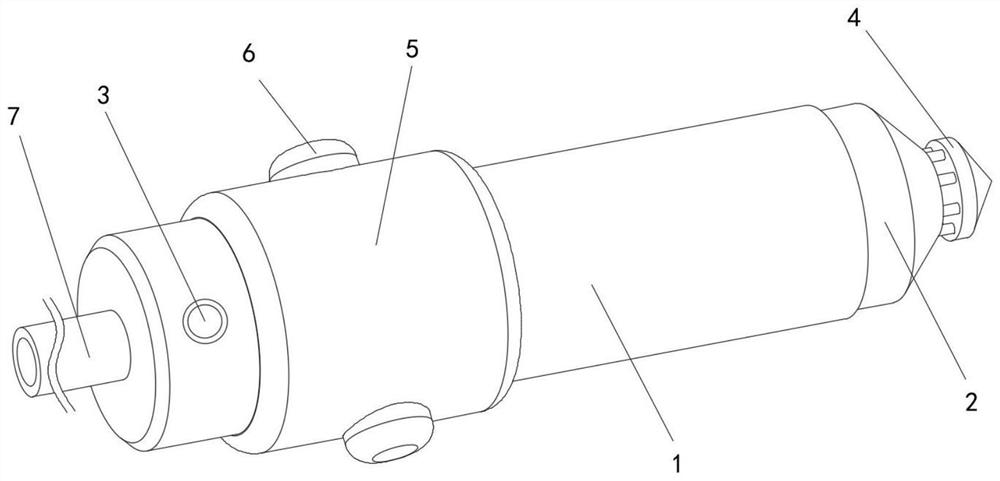Intelligent intracranial pressure detecting and adjusting device
An adjustment device and intracranial pressure technology, applied in the field of medical devices, can solve problems such as detection failure, affecting detection accuracy, and inability to drain drainage of intracranial effusion, so as to improve the efficiency of effusion drainage, save operation time, and increase the success rate Effect
- Summary
- Abstract
- Description
- Claims
- Application Information
AI Technical Summary
Problems solved by technology
Method used
Image
Examples
Embodiment 1
[0035] refer to Figure 1-12, an intelligent intracranial pressure detection and adjustment device, comprising a casing 1, one end of the casing 1 is fixedly installed with a support cylinder 2, and the other end of the support cylinder 2 is fixedly connected with a puncture needle 4 through a plurality of connecting rods. 4. It penetrates to the intracranial area of the surgical patient, and the fluid in the cranial brain enters the interior of the casing 1 evenly through the multiple connecting rod gaps on the inner side of the puncture needle 4. The outer side of the casing 1 is fixedly sleeved with a grip 5, Squeeze keys 6 are slidably installed on both sides of the housing 1, an indicator light 3 is fixedly connected to the outer wall of the housing 1 and located on one side of the hand grip 5, the other end of the housing 1 is fixedly connected with a drainage tube 7, and the There is a manual drainage mechanism inside, and the manual drainage mechanism includes an ela...
Embodiment 2
[0037] like Figure 8-10 As shown, this embodiment is basically the same as Embodiment 1. Preferably, the drainage mechanism includes a limit groove 120 opened inside the solenoid valve 12, and a sleeve is fixedly connected to the inner wall of the limit groove 120 on the side close to the conduit 11. 121 , a valve core 123 is slidably installed inside the limiting groove 120 , two movable rods 122 are symmetrically and fixedly installed at one end of the valve core 123 close to the conduit 11 , and the other ends of the two movable rods 122 are slidably penetrated to the inside of the sleeve 121 . The inside of the sleeve 121 is provided with an electromagnetic drive mechanism. When the manual drainage mechanism works, the conductive slide bar 64 contacts the conductive roller 62 to energize and drive the drainage mechanism to open synchronously. The cooperation between the block 125, the movable rod 122 and the valve core 123 realizes the synchronous opening of the solenoid ...
Embodiment 3
[0039] like Figure 9 As shown, this embodiment is basically the same as Embodiment 1. Preferably, the electromagnetic drive mechanism includes a permanent magnet slider 125 fixedly installed at the end of the movable rod 122, and the other end of the permanent magnet slider 125 is fixedly connected with a second spring 126, The other end of the second spring 126 is fixedly connected with an electromagnet 127 , the other end of the electromagnet 127 is fixedly installed on the inner wall of the solenoid valve 12 , and a first through hole 124 is opened in the center of the solenoid valve 12 . During the deformation process, after the electrical driving components of the drainage mechanism are turned on synchronously, the electromagnet 127 is energized, and under the adsorption action of the electromagnetic force, the permanent magnet slider 125 slides toward the side of the electromagnet 127, so that the second spring is energized. 126 is compressed, which in turn causes the v...
PUM
 Login to View More
Login to View More Abstract
Description
Claims
Application Information
 Login to View More
Login to View More - R&D
- Intellectual Property
- Life Sciences
- Materials
- Tech Scout
- Unparalleled Data Quality
- Higher Quality Content
- 60% Fewer Hallucinations
Browse by: Latest US Patents, China's latest patents, Technical Efficacy Thesaurus, Application Domain, Technology Topic, Popular Technical Reports.
© 2025 PatSnap. All rights reserved.Legal|Privacy policy|Modern Slavery Act Transparency Statement|Sitemap|About US| Contact US: help@patsnap.com



